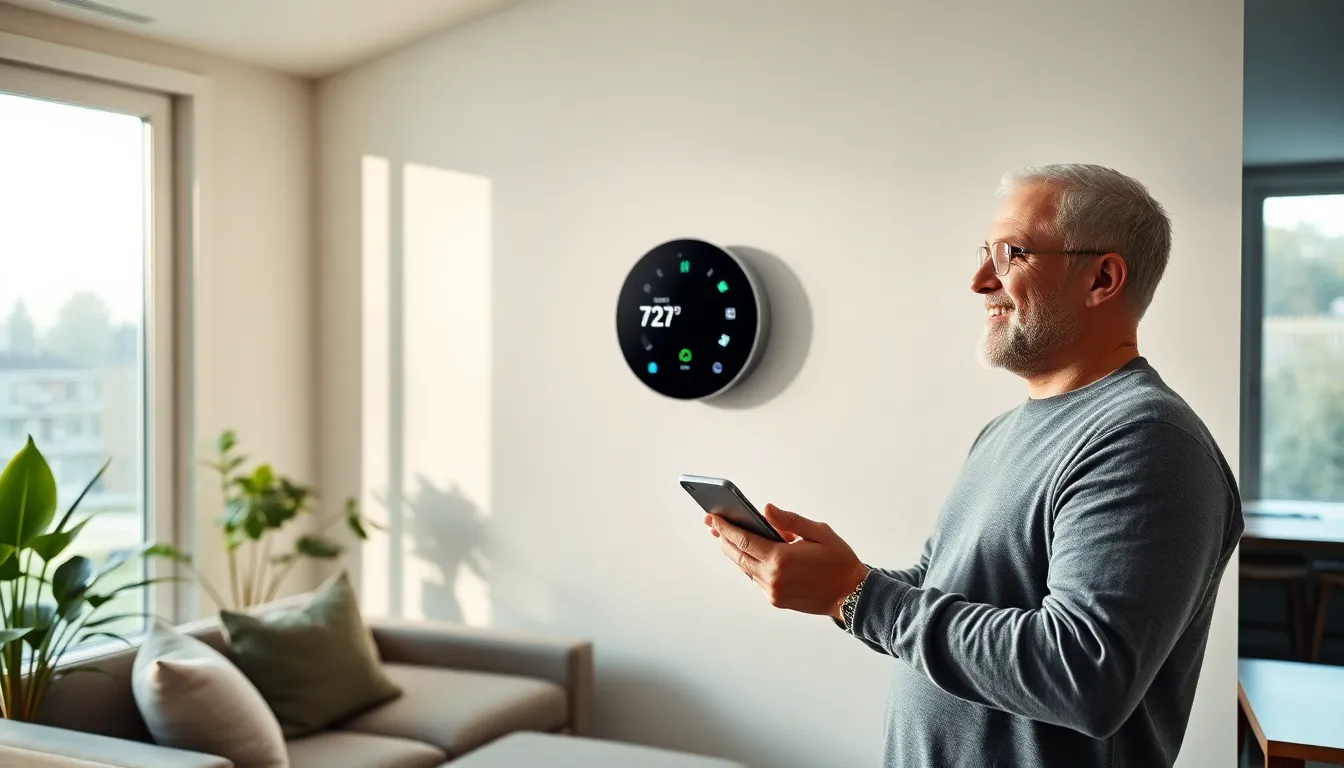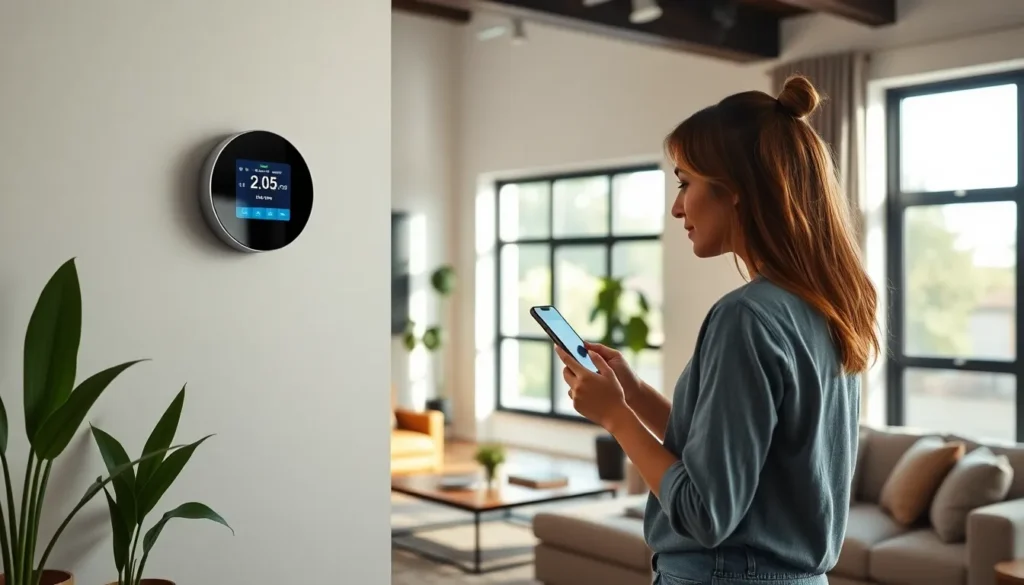Table of Contents
ToggleIn an era where technology seamlessly integrates into daily life, smart home climate control stands out as a game changer. Gone are the days of manual thermostats and unpredictable energy bills. With smart devices, homeowners can now create a comfortable environment tailored to their preferences, all while maximizing energy efficiency.
Imagine adjusting your home’s temperature from anywhere with just a tap on your smartphone. Smart climate systems not only enhance comfort but also contribute to sustainability efforts by reducing energy consumption. As more individuals embrace these innovations, understanding the benefits and functionalities of smart home climate solutions becomes essential for anyone looking to elevate their living space.
Overview of Smart Home Climate
Smart home climate control technology revolutionizes how individuals manage their living environments. Smart devices, including thermostats and sensors, facilitate easy adjustments to temperature settings through smartphone apps, ensuring maximum comfort.
Smart thermostats learn users’ habits, automatically adjusting temperatures based on preferences and occupancy patterns. These automated adjustments lead to significant energy savings, as they reduce heating and cooling when no one is home. For instance, homeowners can save up to 10%-15% on energy bills annually by utilizing these intelligent systems.
Integration with other smart home devices enhances efficiency. When connected to smart lighting and security systems, climate control devices can optimize energy usage further. For example, lights can adjust based on occupancy, while security systems can trigger changes in temperature when someone is at home.
Sustainability remains a crucial factor. Smart climate technology minimizes energy consumption, contributing to lower carbon footprints. By implementing these systems, users support eco-friendly practices while enjoying increased comfort and affordability in their homes.
Overall, understanding smart home climate solutions enables homeowners to enhance their living spaces. These advancements promote convenience, energy efficiency, and sustainability, making smart climate technology an essential aspect of modern home management.
Benefits of Smart Home Climate

Smart home climate systems provide various benefits, significantly enhancing living environments. Key advantages include energy efficiency and improved comfort and convenience.
Energy Efficiency
Smart home climate technology improves energy efficiency by optimizing temperature control. Smart thermostats adapt to users’ schedules, ensuring heating or cooling occurs only when required. This leads to energy savings, with homeowners achieving reductions of 10%-15% on energy bills annually. Integration with other smart devices, like lighting systems, allows for coordinated energy management. For instance, lights can dim automatically when the thermostat adjusts, maximizing overall energy conservation. These systems also utilize data analytics to monitor energy consumption patterns, encouraging behavioral changes that further enhance savings.
Comfort and Convenience
Smart home climate control enhances comfort and convenience through real-time adjustments and remote capabilities. Users can monitor and modify their home’s temperature via smartphone apps, allowing for a customizable environment. Features like geofencing enable the system to automatically adjust temperatures as residents come and go. Moreover, smart sensors detect occupancy levels and respond by optimizing heating or cooling accordingly. This ensures that homes remain comfortable while minimizing unnecessary energy use. Overall, smart home climate solutions make maintaining an ideal living atmosphere effortless and tailored to individual preferences.
Key Components of Smart Home Climate
Smart home climate systems consist of essential components that work together to optimize energy efficiency and enhance comfort. The integration of these technologies allows for precise climate control tailored to homeowners’ needs.
Smart Thermostats
Smart thermostats serve as the central hub for climate control. They analyze usage patterns and adjust settings automatically, ensuring homes remain comfortable. Features like Wi-Fi connectivity allow for remote access via smartphones, enabling real-time temperature adjustments. Many smart thermostats provide energy usage reports, helping homeowners track savings and make informed decisions. Notable models, such as the Nest Learning Thermostat and Ecobee SmartThermostat, showcase advanced learning algorithms and support for voice control, simplifying user interaction further.
Sensors and Controllers
Sensors and controllers play a critical role in the effectiveness of smart home climate systems. Occupancy sensors detect when individuals are present in a room, allowing for precise temperature management based on real-time occupancy. Temperature sensors monitor climate conditions in various rooms, communicating with the central system. Smart controllers link multiple devices, enabling seamless integration of heating, cooling, and ventilation systems. This network of sensors and controllers allows for a comprehensive climate management strategy, adapting to changes and optimizing comfort while saving energy.
Popular Smart Home Climate Solutions
Smart home climate solutions offer a variety of advanced technologies and products designed to enhance energy efficiency and comfort. This section explores leading brands and products in the market, along with a comparison of their key features.
Top Brands and Products
- Nest
Nest Learning Thermostat automatically learns preferences and schedules, optimizing energy use effectively. It offers remote access through a mobile app, providing control from anywhere.
- Ecobee
Ecobee SmartThermostat features room sensors that monitor occupancy and temperature adjustments, ensuring even comfort throughout the home. The built-in Amazon Alexa functionality enhances convenience and entertainment options.
- Honeywell Home
Honeywell Home Lyric T5 provides geofencing technology that adjusts temperature settings based on location. Its user-friendly interface allows for easy scheduling and control via mobile devices.
- Inspirations by Netatmo
Netatmo Smart Thermostat adapts to both user schedules and local weather, offering personalized comfort. Its compatibility with Apple HomeKit, Google Assistant, and Amazon Alexa allows seamless integration with smart home ecosystems.
- August Smart Lock Pro
While primarily a security device, the August Smart Lock Pro integrates with various climate control systems to adjust temperatures when the door is unlocked, improving overall energy efficiency.
Comparison of Features
| Feature | Nest Learning Thermostat | Ecobee SmartThermostat | Honeywell Home Lyric T5 | Netatmo Smart Thermostat | August Smart Lock Pro |
|---|---|---|---|---|---|
| Learning Capability | Yes | Yes | No | Yes | No |
| Remote Access | Yes | Yes | Yes | Yes | Yes |
| Energy Report | Yes | Yes | Yes | Yes | No |
| Integration with Smart Home Systems | Yes | Yes | Yes | Yes | Yes |
| Occupancy Sensors | No | Yes | No | Yes | No |
| Geofencing | Yes | Yes | Yes | No | Yes |
| Voice Control | Yes | Yes | Yes | Yes | Yes |
The comparison highlights differences in learning capabilities, energy reports, and integration options. These factors help consumers make informed decisions when selecting smart climate solutions.
Future Trends in Smart Home Climate
The smart home climate sector continues evolving, driven by advancements in technology and user demands. Homeowners are increasingly adopting AI-enabled systems, which enhance personalization and predictive capabilities. These systems anticipate user preferences, adjusting settings proactively based on behavior and environmental changes.
Integration with Renewable Energy Sources
Smart climate systems increasingly integrate with renewable energy sources, such as solar panels and wind turbines. This integration enables homeowners to optimize energy consumption by utilizing clean energy more efficiently, reducing reliance on grid power. For instance, smart thermostats can schedule heating or cooling during peak solar energy production hours, maximizing energy savings.
Enhanced User Interfaces and Voice Control
Smart home climate solutions are introducing more intuitive user interfaces, including touchscreen displays and mobile applications. These interfaces simplify controlling temperature settings and monitoring energy usage. Voice control functionalities through platforms like Amazon Alexa and Google Assistant also enhance user convenience, allowing homeowners to adjust settings effortlessly.
Data-Driven Insights and Analytics
Innovative smart climate solutions are incorporating advanced analytics to offer data-driven insights. Homeowners receive detailed reports on energy usage, helping them make informed decisions and optimize comfort levels. These insights can highlight patterns, suggesting potential adjustments for improved energy efficiency.
IoT and Interoperability
The Internet of Things (IoT) is further streamlining smart home climate devices, facilitating seamless communication between appliances. Enhanced interoperability ensures that heating, cooling, and ventilation systems work together efficiently. For example, smart thermostats may communicate with air quality sensors to adjust indoor climate based on real-time air quality data.
Behavioral Adaptation Features
Emerging smart climate technologies are incorporating behavioral adaptation features, learning from real-time data and user interactions. These devices use machine learning algorithms to adapt climate control strategies based on individual routines and environmental variables, providing users with tailored comfort experiences.
Focus on Sustainability and Energy Savings
As environmental awareness grows, the demand for eco-friendly smart climate solutions intensifies. Future systems prioritize sustainability by offering features to minimize energy consumption and reduce carbon footprints. Homeowners gain access to features like energy usage tracking, enabling them to evaluate and improve their energy efficiency continuously.
Smart home climate trends indicate a shift towards more personal, efficient, and sustainable living environments. Adapting to these technological advancements enhances overall comfort while supporting eco-friendly practices.
Smart home climate technology represents a significant advancement in how individuals manage their living environments. By embracing these innovative solutions homeowners can enjoy enhanced comfort while simultaneously reducing energy consumption. The integration of smart thermostats and sensors allows for seamless adjustments based on personal preferences and occupancy patterns.
As the demand for energy-efficient and sustainable living grows smart climate systems will continue to evolve. With features like AI-driven personalization and IoT connectivity these technologies not only optimize energy use but also contribute to eco-friendly practices. Adopting smart home climate solutions is a step toward a more efficient and sustainable future.







